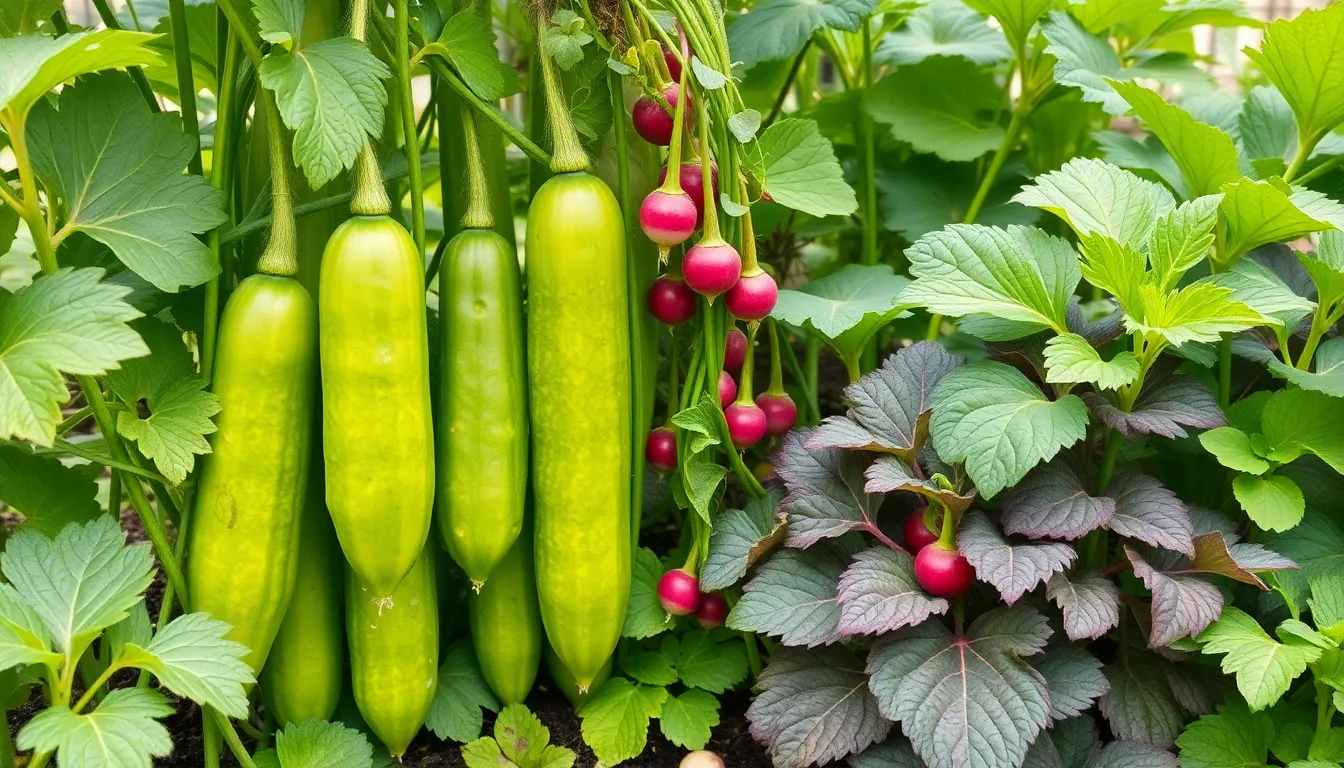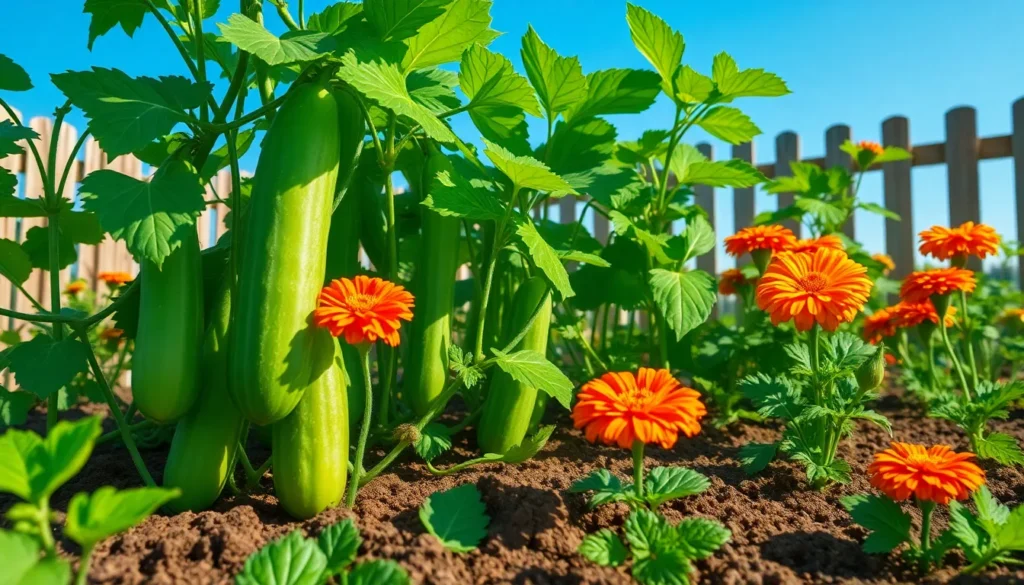Table of Contents
ToggleCucumbers are the cool kids of the garden, but even they need a little help from their friends. If you’ve ever wondered what to plant next to these refreshing veggies, you’re in for a treat. Companion planting isn’t just a garden trend; it’s a secret weapon for boosting growth, flavor, and pest resistance.
Benefits Of Companion Planting
Companion planting offers multiple advantages for growing cucumbers. Neighboring plants support cucumber growth while improving overall garden health.
Improved Growth
Cucumbers benefit significantly from companion plants that provide necessary nutrients. Nitrogen-fixing plants, like legumes, enrich soil fertility, enhancing cucumber health. Additionally, certain flowers attract pollinators, leading to better cucumber yields. Onions and garlic deter harmful pests while not competing for nutrients, promoting robust growth. Each plant’s presence creates a balanced ecosystem, fostering optimal growing conditions.
Pest Control
Companion planting effectively reduces pest issues in cucumber gardens. Marigolds release compounds that repel nematodes and aphids, protecting nearby cucumber plants. Basil attracts beneficial insects that prey on common pests, improving cucumber vitality. Moreover, planting radishes can deter cucumber beetles while providing space efficiency. Healthy plant relationships often lead to decreased reliance on chemical pesticides, promoting a more sustainable gardening process.
Ideal Companion Plants For Cucumbers

Companion plants enhance cucumber growth and offer numerous benefits. This section covers two ideal options: beans and radishes.
Beans
Beans thrive alongside cucumbers by enriching the soil with nitrogen. They improve soil fertility, which supports cucumber plants. Choosing varieties such as pole beans or bush beans provides ample ground cover, helping to retain soil moisture. Planting beans near cucumbers also reduces weed competition. Additionally, beans produce flowers that attract beneficial pollinators, aiding cucumber yields. Mixing different varieties such as kidney, black, or pinto beans enhances biodiversity in the garden.
Radishes
Radishes serve as effective companions for cucumbers due to their rapid growth cycle. These plants mature quickly, allowing for early harvesting while providing ground cover. Radishes deter certain pests that target cucumbers, contributing to healthier plants. The spicy scent of radishes can confuse pests like cucumber beetles. They also create an environment that promotes air circulation, reducing the risk of fungal diseases. Planting varieties like cherry belle or daikon radishes enhances garden diversity while benefiting cucumbers.
Plants To Avoid Near Cucumbers
Cucumbers benefit from certain companion plants, but some can hinder their growth. Awareness of plants that may negatively impact cucumbers ensures better health and yield.
Strong Smelling Herbs
Strong smelling herbs, like mint and sage, hinder cucumber growth. Mint spreads aggressively and competes for resources, leaving cucumbers with limited nutrients. Sage’s intense aroma may repel pollinators, reducing cucumber flower visitation. Avoid planting these herbs within close proximity to cucumbers to maintain ideal growing conditions.
Other Cucurbit Family Members
Other cucurbit family members, such as melons and pumpkins, create competition for nutrients and water. Planting cucumbers alongside these crops often leads to pest attraction, increasing vulnerability to diseases. Squash can also cross-pollinate with cucumbers, potentially altering flavor and texture. Keep these plants separated to ensure cucumbers grow healthy and productive.
Tips For Successful Companion Planting
Successful companion planting enhances cucumber growth and overall garden health. Selecting proper planting techniques and considering seasonal factors play significant roles in maximizing these benefits.
Planting Techniques
Proper spacing between cucumbers and companion plants encourages airflow and reduces disease risk. Planting beans alongside cucumbers provides nitrogen enrichment and ground cover. Heaving dense ground coverage prevents weed growth and retains soil moisture. Interplanting radishes among cucumbers offers a natural way to deter pests, promoting healthy growth. Using vertical planting for climbing beans can optimize space usage. Mulching around the base of cucumbers retains moisture and suppresses weeds while adding nutrients as it decomposes.
Seasonal Considerations
Timing matters when planting companion crops. Early spring planting aligns with cucumber sowing, allowing for robust growth while temperatures are moderate. Consider staggered planting techniques to extend harvest periods and ensure continuous pollination. Warm summer days benefit cucumbers and their companions by promoting growth; planting basil, for instance, encourages pollinators during this time. Additionally, late summer companion planting of fall crops aids in soil nourishment for the next season. Evaluating local climate conditions ensures vegetables thrive together effectively.
Companion planting offers a strategic approach to growing cucumbers that can significantly enhance their health and yield. By selecting the right neighboring plants like beans and radishes, gardeners can create a thriving ecosystem that promotes soil fertility and attracts beneficial insects. Avoiding plants that compete for nutrients or repel pollinators is equally important for maintaining cucumber vitality.
Implementing proper spacing and seasonal planting techniques further ensures a successful garden. With these practices in mind, anyone can cultivate a flourishing cucumber patch that not only thrives but also contributes to a sustainable gardening environment. Embracing the art of companion planting can lead to bountiful harvests and a healthier garden overall.







